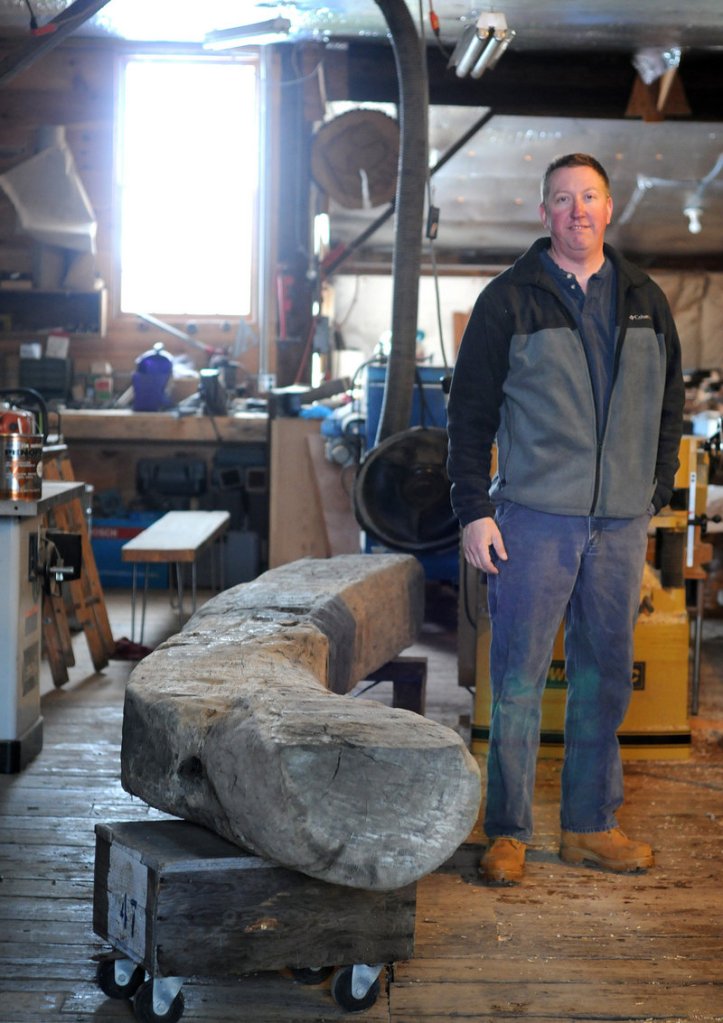ATHOL, Mass. – If wood could talk, the old beams in Thomas Mann’s lumber yard would sound like a chatty ship’s bosun.
They are gnarly, tough and interesting.
“They are nearly bulletproof,” Mann said.
Mann, owner of Mann Lumber Co., has a big pile of dark-colored beams in his yard that are unlike other salvaged materials he has collected for resale.
First of all, these beams are not his. They belong to Partners HealthCare, the parent company of Spaulding Rehabilitation Hospital.
The beams are special in part because they are probably at least 300 years old and were buried in the former Charlestown Naval Yard before the Civil War, possibly to preserve them for use in repairing sailing vessels.
They were discovered when the company started construction on a new Spaulding Rehabilitation Hospital on one of the parcels at the former naval yard.
“When they went to build a new waterfront hospital, they discovered lots and lots of them buried in the former naval yard,” Mann said.
Mann has had the timbers for two years, waiting for Partners HealthCare to decide what to do with them. Only recently has he gotten the green light to start a project: a two-piece bench.
SIGNIFICANCE GRASPED
When the wood was discovered, Mann said, the owners immediately grasped the importance of what they found.
He said the beams are pieces of seafaring history. When ships were built, he said shipyards often kept duplicate pieces of wood to repair any damage.
The beams are all numbered, as if they were part of an inventory the Navy was keeping before the era of wooden ships ended.
Partners HealthCare chose not to just sell it off, giving about 140 pieces to Mystic Seaport: The Museum of America and the Sea in Mystic, Conn., and keeping the rest to do something to honor the wood and its history.
“They knew they had to do something with it,” he said.
Mann said the wood is live oak, an evergreen oak found in the South. For wooden ships the wood was much sought after, because the unusual grain makes the wood extremely hard.
“It also grows curved, which makes it good for shipbuilding,” Mann said.
BACK TO THE SEA, ON A SHIP
Once the company figured out that the large logs were for building and repairing old sailing vessels, the company gave three-quarters of them to the Mystic museum, which is in the middle of restoring the world’s last surviving wooden whaling vessel, the Charles W. Morgan.
The vessel is undergoing a $10 million restoration. The timbers, which are in remarkably good condition, considering they have been buried since the mid-1800s, are the same type of wood used to build the Morgan in 1841.
The wood was a bonanza for the Mystic, Conn., ship museum, which had taken to reclaiming live oaks that had fallen for some reason, including many trees that were blown down by Hurricane Katrina in 2005.
HOSPITAL MULLS USE – FOR YEARS
“The hospital kept 25 percent of the wood so it could be put to some reuse,” Mann said.
But finding an eventual reuse involved two years of the hospital building project’s architects accepting and rejecting designs that would not work in some way with the overall design or would be a problem to create out of the wood.
The ideas included making furniture for offices for the hospital, or installing it in some way into the design of the building.
For two years, designs were put forward that were just not what the hospital wanted.
“They kept trying to come up with designs instead of letting the wood decide what it wants to have done,” Mann said.
A WELCOME STEWARDSHIP
Mann’s yard is filled with wood and other building materials he has purchased that he will either rework and sell, or resell outright, including a 40-foot beam from an old mill in Merrimac he said may be close to 400 years old.
Of the Charlestown Naval Yard wood, he said, “I am only its steward for a while.”
The beams came to Mann after he bought a new sawmill. Another sawmill owner had the responsibility of using the old wood, but he was retiring.
After an extensive vetting process, Mann said it was decided he had the knowledge and equipment to properly work with the wood. One of the factors in his favor is that his family has been in the wood business for three generations.
A PAIR OF PROJECTS AT LAST
On the last day of 2012, hospital officials contacted him and told him they had a plan for some of the wood.
Within days he was working on his first commission: a two-piece bench that will be installed in a public area between the hospital and the waterfront.
The piece he is working on first is a few feet thick with a beautiful curve to it.
He has been working to dry it out and smooth it off enough so it will be comfortable for public use.
He said it will not be sanded down much because the owners want the character of the wood to be retained as much as possible.
The bench will be substantial: A second piece of it is on a flatbed truck. Mann said he plans to unload it into his wood shop and work on it side by side with the other piece.
A second, single-piece bench is also being made.
The rest of the wood, a few dozen large pieces, including one that is about 31 inches square, is still being looked at by the architects.
And eventually, Mann said, the wood will let them know what it should become.
Send questions/comments to the editors.



Comments are no longer available on this story